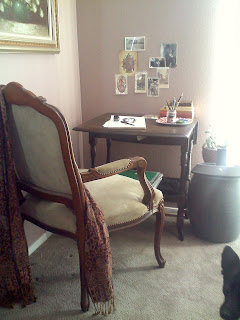"I can't think of what to paint/draw/perform/write so I think I shall rearrange/clean/reorganize/add on to/ build/design/dream about/blog about my art studio/work space."
Clearly, I am not an exception to this process. (Art-linguistics lesson: When you are an artist and you called something a "process" it makes "goofing off" sound fancy and important.)
My main workspace is my kitchen. When my daughter and I decide to eat dinner at the kitchen table we carefully clear everything away into various toolboxes, boxes and crates and then I move it all back out again the next time I go to work. Generally, the tabletop resembles the inside of my brain, which is a fun place for me but sort of scattered and definitely influenced by mild ADD. I'm okay living with this, because it's my process. (Here "process" means "my damn house because I pay the mortgage.")
This art space works when I am in the frantic, busy place of working on an actual painting, but that is really the end of a long process (here "process" means "piles of sketches on napkins-in notebooks-on the back of junkmail, months of indecision on a color palette, taping paper down to boards while watching The Daily Show to kill time, drawing the same little person a kajillion times from various angles and in various environments so that I can spend 12 hours straight turning six months of 'scattered and crazy' into a finished piece.") When I actually draw, though, I want order. Maybe it's the black and white sensibility of drawing or its linearity but I need a more settled and quiet space to work on the drawing sections of my pieces. So to that end, I spent a large chunk of time yesterday (when I could have been working) creating a second art/work space in my home. I give you, the drawing table: (now doesn't that sound snooty?)
 That's Dorothy, the mutt, peeking into the picture. She was distressed that I was rearranging her room, which is technically my room, but she chooses to not recognize the difference.
That's Dorothy, the mutt, peeking into the picture. She was distressed that I was rearranging her room, which is technically my room, but she chooses to not recognize the difference.It did feel a little like procrastination, BUT when I was done all I wanted to do was sit down and draw there. Which I did. See? It's all part of the process.




